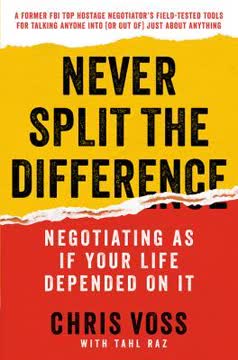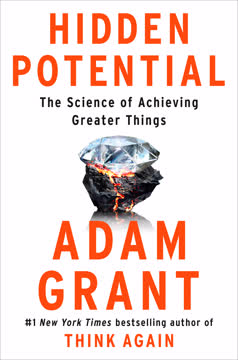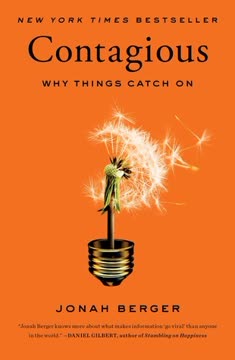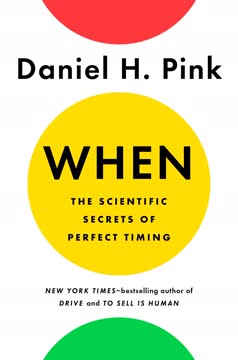Key Takeaways
1. We're all in sales now: Moving others is universal
"Leave aside sleep, exercise, and hygiene, and it turns out that I spend a significant portion of my days trying to coax others to part with resources."
Redefining sales. The traditional notion of sales as a distinct profession is outdated. In today's economy, everyone engages in "non-sales selling" – persuading, influencing, and convincing others to part with resources. This includes teachers motivating students, doctors encouraging patients to follow treatment plans, and entrepreneurs pitching ideas.
Prevalence of selling. Research shows that people spend about 40% of their work time selling in some form. This applies across various professions and industries, not just traditional sales roles. The rise of small entrepreneurs, the need for elastic skills in established companies, and the growth of the education and healthcare sectors (Ed-Med) have all contributed to this shift.
Breaking stereotypes. The negative stereotypes associated with sales – pushy, dishonest, manipulative – are outdated. Modern selling is about moving others through understanding, empathy, and service. It's a fundamental human skill that can be developed and refined.
2. The new ABCs of selling: Attunement, Buoyancy, and Clarity
"Attunement, buoyancy, and clarity: These three qualities, which emerge from a rich trove of social science research, are the new requirements for effectively moving others on the remade landscape of the twenty-first century."
Attunement is the ability to bring one's actions and outlook into harmony with other people and the context. It involves perspective-taking, reading emotions, and adapting to different situations. This skill helps in understanding the needs and motivations of others, making it easier to influence them.
Buoyancy is the capacity to stay afloat in an "ocean of rejection." It combines a positive mindset with resilience, helping individuals bounce back from the frequent rejections inherent in sales and persuasion. Techniques like interrogative self-talk and explanatory style contribute to buoyancy.
Clarity is about making sense of information and helping others see their situations in fresh ways. In an age of information abundance, the ability to curate information, frame choices, and uncover problems is crucial. Clarity involves both problem-finding and problem-solving skills.
3. Attunement: Perspective-taking and social cartography
"To sell well is to convince someone else to part with resources—not to deprive that person, but to leave him better off in the end."
Power paradox. Research shows an inverse relationship between power and perspective-taking ability. To attune effectively, assume a position of lower power, which enhances your ability to see from others' viewpoints.
Cognitive empathy. While emotional empathy is valuable, perspective-taking (cognitive empathy) is more effective in moving others. It allows for better calibration between cooperation and competition, leading to mutually beneficial outcomes.
Social cartography. Develop the ability to map social relationships and dynamics in any given situation. This skill helps in understanding the key players, their motivations, and how to best approach them.
- Strategic mimicry: Subtly mirroring others' body language and speech patterns can build rapport and trust.
- Ambivert advantage: People in the middle of the introversion-extraversion spectrum often make the best salespeople due to their balanced approach.
4. Buoyancy: Staying afloat in an ocean of rejection
"The hardest part of selling, Norman Hall says, occurs before his well-polished shoes even touch the streets of San Francisco. 'Just getting myself out of the house and facing people' is the stiffest challenge, he says."
Interrogative self-talk. Instead of pumping yourself up with declarative statements, ask yourself questions like "Can I do this?" Research shows this approach is more effective in preparing for challenging tasks.
Positivity ratios. Aim for a 3-to-1 ratio of positive to negative emotions for optimal performance. This balance provides enough positivity for flourishing while retaining the benefits of "appropriate negativity."
Explanatory style. How you explain negative events affects your resilience. Develop an optimistic explanatory style by viewing setbacks as temporary, specific, and external rather than permanent, pervasive, and personal.
- Before: Use interrogative self-talk to prepare
- During: Maintain a positive-to-negative emotion ratio of about 3-to-1
- After: Explain setbacks with an optimistic style
5. Clarity: Curating information and finding problems
"Clarity depends on contrast."
Problem-finding. In an age of abundant information, the ability to identify the right problems to solve is more valuable than pure problem-solving. Develop skills in uncovering hidden issues and framing situations in new ways.
Framing choices. Use contrast and comparison to clarify options. Five effective frames:
- The less frame: Limit choices to make decisions easier
- The experience frame: Emphasize experiences over material goods
- The label frame: Use labels to set expectations
- The blemished frame: Highlight a minor flaw to enhance perceived value
- The potential frame: Focus on future possibilities rather than past accomplishments
Curation. Develop skills in sorting through vast amounts of information to present the most relevant and clarifying pieces. This helps others make sense of complex situations and make better decisions.
6. From elevator pitch to six successors: Evolving persuasion
"The purpose of a pitch isn't necessarily to move others immediately to adopt your idea. The purpose is to offer something so compelling that it begins a conversation, brings the other person in as a participant, and eventually arrives at an outcome that appeals to both of you."
Elevator pitch evolution. The traditional elevator pitch is outdated in today's fast-paced, information-rich environment. Six modern alternatives:
- One-word pitch: Distill your message to a single, powerful word
- Question pitch: Frame your pitch as a thought-provoking question
- Rhyming pitch: Use rhyme to increase memorability and perceived accuracy
- Subject line pitch: Craft email subject lines that promise utility or pique curiosity
- Twitter pitch: Convey your message in 140 characters or less
- Pixar pitch: Use a six-sentence narrative structure inspired by Pixar's storytelling formula
These new pitching techniques are designed to start conversations, engage the other person, and lead to collaborative outcomes rather than immediate decisions.
7. Improvise: Listen, accept, and make your partner look good
"The bread and butter of improv is hearing offers."
Hearing offers. Train yourself to listen deeply and recognize potential opportunities in every interaction. What seems like an objection might be an offer in disguise.
Say "Yes and." Instead of rejecting ideas or using "Yes, but," build on others' suggestions with "Yes, and." This approach fosters creativity and collaboration.
Make your partner look good. Focus on mutual benefit rather than personal gain. By helping others succeed, you create better outcomes for everyone involved.
- Active listening: Practice "listening without listening for anything"
- Acceptance: Treat every statement as an offer you can build upon
- Collaboration: Aim for win-win situations rather than personal victories
8. Serve: Make it personal and purposeful
"If the person you're selling to agrees to buy, will his or her life improve? When your interaction is over, will the world be a better place than when you began?"
Personal connection. Humanize your interactions by recognizing the individual behind each transaction. This approach improves performance and outcomes in various fields, from medicine to customer service.
Purposeful action. Tap into people's innate desire to contribute to something larger than themselves. Frame actions in terms of how they benefit others or serve a greater purpose.
Upserving, not upselling. Instead of trying to increase what others can do for you, focus on elevating what you can do for them. This approach builds trust and long-term relationships.
- Make it personal: See the human being behind every interaction
- Make it purposeful: Connect actions to larger, meaningful goals
- Serve first, sell second: Prioritize improving others' lives over immediate gains
Last updated:
FAQ
What's "To Sell Is Human" by Daniel H. Pink about?
- Exploration of Sales: The book explores the idea that everyone is in sales now, whether they realize it or not, due to the nature of modern work and life.
- Changing Sales Landscape: It discusses how the sales landscape has changed from a world of information asymmetry to one of information parity, where both buyers and sellers have access to the same information.
- New ABCs of Selling: Pink introduces the new ABCs of selling: Attunement, Buoyancy, and Clarity, which are essential for moving others in today's world.
- Human Element in Selling: The book emphasizes the importance of understanding human behavior and psychology in the process of selling and influencing others.
Why should I read "To Sell Is Human"?
- Universal Relevance: The book is relevant to anyone who needs to persuade, influence, or convince others, which is a part of almost every profession.
- Practical Advice: It offers practical techniques and strategies that can be applied in both professional and personal contexts to improve one's ability to move others.
- Insightful Research: Pink draws on a wealth of social science research to back up his claims, providing a solid foundation for his advice.
- Engaging Writing: The book is written in an engaging and accessible style, making complex concepts easy to understand and apply.
What are the key takeaways of "To Sell Is Human"?
- Everyone is in Sales: Regardless of your job title, you are likely spending a significant portion of your time persuading, influencing, and convincing others.
- New ABCs: Attunement, Buoyancy, and Clarity are the new essential qualities for effective selling and influencing.
- Importance of Empathy: Understanding and empathizing with others' perspectives is crucial for successful persuasion.
- Service Orientation: Selling should be about serving others and improving their lives, which in turn can improve the world.
What are the best quotes from "To Sell Is Human" and what do they mean?
- "We're all in sales now.": This quote encapsulates the book's central thesis that selling is no longer confined to traditional sales roles but is a universal skill.
- "The ability to move others to exchange what they have for what we have is crucial to our survival and our happiness.": This highlights the fundamental human nature of selling and its importance in everyday life.
- "To sell is human.": This phrase underscores the idea that selling is an intrinsic part of human interaction and not just a business activity.
- "The new ABCs of selling are Attunement, Buoyancy, and Clarity.": This quote introduces the core framework of the book, emphasizing the skills needed in modern selling.
What is the concept of "Attunement" in "To Sell Is Human"?
- Understanding Others: Attunement is about aligning your actions and outlook with those of others to better understand their perspectives.
- Power and Perspective: It involves reducing your power to enhance your ability to take another's perspective, which is crucial for effective persuasion.
- Empathy vs. Perspective-Taking: While empathy is about feeling, perspective-taking is about thinking, and the latter is more effective in moving others.
- Strategic Mimicry: Attunement includes the use of strategic mimicry to build rapport and trust with others.
How does "Buoyancy" help in selling according to Daniel H. Pink?
- Handling Rejection: Buoyancy is about staying afloat in an ocean of rejection, which is a common experience in sales.
- Interrogative Self-Talk: Before engaging in selling, using interrogative self-talk (asking questions) can be more effective than declarative self-talk (affirmations).
- Positivity Ratios: Maintaining a healthy ratio of positive to negative emotions can enhance one's ability to persuade and influence.
- Optimistic Explanatory Style: Interpreting setbacks as temporary and specific rather than permanent and pervasive helps maintain motivation and persistence.
What role does "Clarity" play in moving others in "To Sell Is Human"?
- Problem Finding: Clarity involves helping others see their situations in new ways and identifying problems they didn't realize they had.
- Framing: Using different frames, such as the less frame or the experience frame, can help clarify the value of what you're offering.
- Curating Information: In a world of abundant information, being able to curate and present the most relevant data is crucial.
- Asking Questions: Good salespeople are skilled at asking questions that uncover latent issues and possibilities.
How does Daniel H. Pink suggest we should "Pitch" in "To Sell Is Human"?
- Beyond the Elevator Pitch: Pink suggests moving beyond the traditional elevator pitch to more varied and effective methods.
- Six Successors: He introduces six types of pitches: the one-word pitch, the question pitch, the rhyming pitch, the subject-line pitch, the Twitter pitch, and the Pixar pitch.
- Engagement and Collaboration: The purpose of a pitch is to start a conversation and engage the other person as a collaborator.
- Clarity and Brevity: Effective pitches are clear, concise, and tailored to the audience's needs and interests.
What is the significance of "Improvise" in selling according to the book?
- Adaptability: Improvisation is about being adaptable and responsive to changing situations and unexpected challenges.
- Hearing Offers: It involves listening carefully to what others are saying and seeing objections as offers to build upon.
- "Yes and" Technique: This technique encourages building on others' ideas rather than shutting them down, fostering collaboration and creativity.
- Making Others Look Good: By focusing on making your partner look good, you create a positive and productive interaction.
How does "To Sell Is Human" redefine the concept of "Service"?
- Service as a Core Element: Selling is fundamentally about serving others and improving their lives.
- Make it Personal: Personalizing interactions and seeing the human being behind the transaction can enhance service quality.
- Make it Purposeful: Emphasizing the purpose and impact of what you're offering can motivate both you and the buyer.
- Servant Selling: The book advocates for a servant selling approach, where the seller's primary goal is to serve the buyer's needs.
What are some practical exercises from "To Sell Is Human" to improve selling skills?
- Interrogative Self-Talk: Practice asking yourself questions before engaging in selling to boost confidence and strategy.
- Strategic Mimicry: Use subtle mimicry in conversations to build rapport and trust with others.
- "Yes and" Exercise: Practice the "Yes and" technique to enhance collaboration and creativity in interactions.
- Emotionally Intelligent Signage: Create signs that empathize with the viewer and highlight the purpose behind rules or requests.
How does "To Sell Is Human" address the myths about salespeople?
- Blockhead Myth: The book dispels the myth that salespeople are less intelligent, showing that modern selling requires creativity and intellect.
- Moneygrubber Myth: It challenges the notion that salespeople are solely motivated by money, highlighting the importance of intrinsic motivation.
- Natural-Born Salesman Myth: Pink argues that anyone can learn to sell effectively, as selling is a natural human activity.
- Sleazy Salesman Stereotype: The book addresses the negative stereotype of salespeople as deceitful, emphasizing the shift towards transparency and honesty.
Review Summary
To Sell Is Human receives mixed reviews, with praise for its accessible style and insights into modern selling techniques. Readers appreciate Pink's emphasis on ethical selling and servant leadership. The book redefines selling as persuasion in everyday life, not just traditional sales roles. Some criticize it for lacking depth or originality. Many find the concepts on attunement, buoyancy, and clarity helpful. The book's practical tips and research-backed ideas are generally well-received, though some feel it tries to appeal to too broad an audience.
Similar Books










Download PDF
Download EPUB
.epub digital book format is ideal for reading ebooks on phones, tablets, and e-readers.








